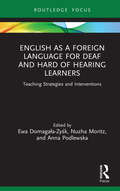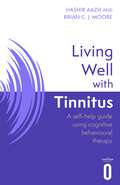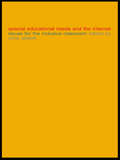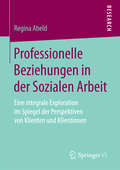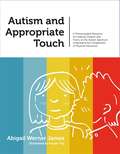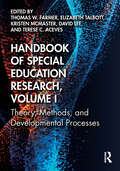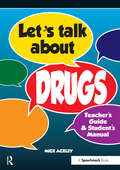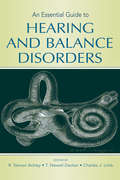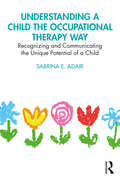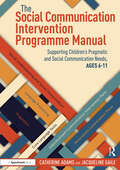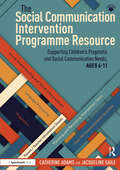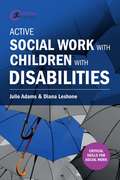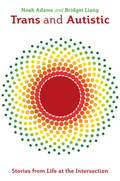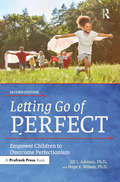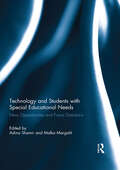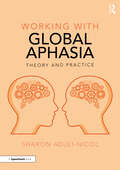- Table View
- List View
English as a Foreign Language for Deaf and Hard of Hearing Learners: Teaching Strategies and Interventions (Routledge Research in Special Educational Needs)
by Ewa Domaga 322 A-Zy 347 K Nuzha Moritz Anna PodlewskaThis book outlines best practice and effective strategies for teaching English as a foreign language to D/deaf and hard of hearing (DHH) students. Written by a group of researchers and experienced practitioners, the book presents a combination of theory, hands-on experience, and insight from DHH students. The book brings together a variety of tried and tested teaching ideas primarily designed to be used for classroom work as a basis for standby lessons or to supplement courses. Placing considerable emphasis on practical strategies, it provides educators and practitioners with stimulating ideas that facilitate the emergence of fluency and communication skills. The chapters cover a wide range of interventions and strategies including early education teaching strategies, using sign -bilingualism in the classroom, enhancing oral communication, speech visualization, improving pronunciation, using films and cartoons, lip reading techniques, written support, and harnessing writing as a memory strategy. Full of practical guidance grounded in theory, the book will be a useful resource for English teachers and all those involved in the education of deaf and hard of hearing learners across the world; including researchers, student teachers, newly qualified teachers, school supervisors, and counsellors.
Living Well with Tinnitus: A self-help guide using cognitive behavioural therapy (Living Well #1)
by Hashir Aazh Brian C.J. Moore'With real life examples to guide the reader and proven cognitive behavioural techniques, this will help people to overcome the distress associated with tinnitus and live a meaningful life'Dr Rory Allott, Greater Manchester NHS Foundation TrustWorldwide, about one billion people experience tinnitus at some point in their life. It is a life-changing experience for many of them. Learning effective management strategies in a timely fashion is the key to dealing with this difficult condition.This book combines cutting-edge knowledge of auditory science and theoretical frameworks in modern psychology with insight and real-life, human examples from clinical practice. Packed with metaphors and practical tips, the authors aid understanding of complex concepts by introducing an accessible and entertaining cast of characters from history and fiction, from Beauty and the Beast to Moby Dick, from Dante to Muhammad Ali, and from Sigmund Freud to Rumi.By following the advice in this book, you will:· Gain a realistic picture of what the recovery from tinnitus-related distress looks like· Learn how to go beyond the difficulties and annoyance caused by tinnitus and pay attention to the meanings behind those experiences· Develop skills that are proven to help on your journey.Everything that you need to know about living well with tinnitus is presented in ten steps!Living Well self-help guides use clinically proven techniques to treat long-standing and disabling conditions, both psychological and physical.Series Editors: Professor Kate Harvey and Emeritus Professor Peter Cooper
Special Educational Needs and the Internet: Issues for the Inclusive Classroom
by Chris AbbottWith Internet access for every school now a reality, teachers are beginning to explore the use of the Internet in the education of children with special needs. This book describes its benefits for children across the spectrum of special educational needs, from those with physical disabilities or sensory impairment to those with learning or social difficulties.With contributions from leading practitioners in the field, this book addresses the huge range of possibilities the Internet and associated technology offer for these pupils. Combining current theory and debate with practical guidance and inspiring case studies, this book considers:* how the Internet can be used to gather and publish information* how to communicate effectively through technology* policy and management issues for schools* the continuing challenges for access and inclusion.This book will be of interest to all teachers involved in special education needs, in both mainstream and special schools.
Special Educational Needs and the Internet: Issues for the Inclusive Classroom
by Chris AbbottWith Internet access for every school now a reality, teachers are beginning to explore the use of the Internet in the education of children with special needs. This book describes its benefits for children across the spectrum of special educational needs, from those with physical disabilities or sensory impairment to those with learning or social difficulties.With contributions from leading practitioners in the field, this book addresses the huge range of possibilities the Internet and associated technology offer for these pupils. Combining current theory and debate with practical guidance and inspiring case studies, this book considers:* how the Internet can be used to gather and publish information* how to communicate effectively through technology* policy and management issues for schools* the continuing challenges for access and inclusion.This book will be of interest to all teachers involved in special education needs, in both mainstream and special schools.
Professionelle Beziehungen in der Sozialen Arbeit: Eine integrale Exploration im Spiegel der Perspektiven von Klienten und Klientinnen
by Regina AbeldRegina Abeld wählt in diesem Buch das Missverhältnis als Ausgangspunkt, dass zwischen dem einerseits hohen Stellenwert der sozialarbeiterischen Fachkraft-Klient-Beziehung und andererseits der Randständigkeit des Themas in Praxis und Theorie besteht. In der Exploration dieses so zentralen Themas legt die Autorin einen zugleich empirisch-praktischen wie konzeptionell-theoretischen Entwurf vor. Sie stützt sich dabei auf die empirisch erhobene Perspektive von Klienten und Klientinnen der Gemeindepsychiatrie und greift Desiderate einer modernen bzw. postmodernen Theorie Sozialer Arbeit auf. Verbunden werden diese mit metatheoretischen Überlegungen zu den Konzepten „Habitus“ und „Identität“ sowie mit Bezügen zur Ethik und münden schließlich in die konzeptionelle Beschreibung einer „integralen professionellen Beziehungsgestaltung“.
Autism and Appropriate Touch: A Photocopiable Resource for Helping Children and Teens on the Autism Spectrum Understand the Complexities of Physical Interaction (PDF)
by Abigail Werner Werner James Kaiyee TayThis is a practical educational resource to help teach the social rules of touch and personal space to children and teens with Autism Spectrum Disorder with the aim of keeping them safe and helping them to understand what are appropriate interactions in family, educational and community situations. The lessons in the book look at different groups of people that the child is likely to encounter such as close family members, teachers, peers, strangers and medical professionals. Through photocopiable worksheets and activities children are taught about different types of touch and in what settings, where on the body, and for how long touch is appropriate with each group. The book also includes discussion on how best to teach the child to recognise if someone touches them inappropriately and what is appropriate when it comes to self-touch.
Handbook of Special Education Research, Volume I: Theory, Methods, and Developmental Processes
by Terese C. Aceves Thomas W. Farmer Elizabeth Talbott Kristen McMaster David LeeDivided into two volumes, Handbook of Special Education Research provides a comprehensive overview of critical issues in special education research. This first volume addresses key topics in theory, methods, and development, exploring how these three domains interconnect to build effective special education research. Each chapter features considerations for future research and implications for fostering continuous improvement and innovation. Essential reading for researchers and students of special education, this handbook brings together diverse and complementary perspectives to help move the field forward.
Let's Talk About Drugs: Teacher's Guide & Student's Manual
by Michael AckleyEffective drug education is key to steering young people away from drug use, whether in a group setting or one to one. This workbook provides a fun way to learn about drugs with a teacher or youth worker, parent or carer. The approaches include: information giving; life skills education; and mixed approaches. Packed with important information, strategies and facts, the following subjects are included: what is a drug; drug word game; drug names and nicknames; using drugs - for and against; the effects of drugs; risks and dangers of drugs; drugs and the law; keeping safe; resisting peer pressure; tobacco; and alcohol. A great deal of information provided in this easy to use package. Paperback & CD.
An Essential Guide to Hearing and Balance Disorders
by R. Steven Ackley T. Newell Decker Charles J. LimbAn Essential Guide to Hearing and Balance Disorders consolidates the most significant clinical aspects of hearing and balance disorders, ranging from cause and diagnosis to treatment and cure. Experts in various subspecialties of this extensive topic introduce readers to the most sophisticated and state of the art methods of diagnosis and treatment. Each chapter expands on a specific topic area along the continuum of how medical personnel diagnose hearing and balance disorders, to how surgical implantation of the cochlea and rehabilitation can remedy various conditions. In concise format, the book begins with a case history and follows with comprehensive descriptions of current knowledge regarding fundamental causes of hearing loss and balance disorders, as well as a thorough examination of objective assessment. The latter half of the volume presents specialized treatment and rehabilitative options for various disorders. The chapters in this part cover special topics and conclude with pertinent case studies. Unique areas of discussion in a text of this kind include: genetics of deafness pediatric hearing loss and hearing loss later in life business essentials in audiology private practice professional issues, such as ethics, methods of practice, and conflicts of interest. As its title implies, this book is critically important for all students and professionals in hearing/balance related disciplines, including audiology, otolaryngology, general medicine, and rehabilitation oriented allied health care occupations.
An Essential Guide to Hearing and Balance Disorders
by R. Steven Ackley T. Newell Decker Charles J. LimbAn Essential Guide to Hearing and Balance Disorders consolidates the most significant clinical aspects of hearing and balance disorders, ranging from cause and diagnosis to treatment and cure. Experts in various subspecialties of this extensive topic introduce readers to the most sophisticated and state of the art methods of diagnosis and treatment. Each chapter expands on a specific topic area along the continuum of how medical personnel diagnose hearing and balance disorders, to how surgical implantation of the cochlea and rehabilitation can remedy various conditions. In concise format, the book begins with a case history and follows with comprehensive descriptions of current knowledge regarding fundamental causes of hearing loss and balance disorders, as well as a thorough examination of objective assessment. The latter half of the volume presents specialized treatment and rehabilitative options for various disorders. The chapters in this part cover special topics and conclude with pertinent case studies. Unique areas of discussion in a text of this kind include: genetics of deafness pediatric hearing loss and hearing loss later in life business essentials in audiology private practice professional issues, such as ethics, methods of practice, and conflicts of interest. As its title implies, this book is critically important for all students and professionals in hearing/balance related disciplines, including audiology, otolaryngology, general medicine, and rehabilitation oriented allied health care occupations.
Understanding a Child the Occupational Therapy Way: Recognizing and Communicating the Unique Potential of a Child
by Sabrina E. AdairThis book uses an occupational therapy way of thinking to guide the reader towards observing, understanding, and communicating the needs of children to foster a supportive environment. Presented in accessible, everyday language, this book takes a holistic approach of looking at a child from what makes them a unique person, what activities they are trying to accomplish, and what environment they are in. Each chapter helps readers identify, describe, and clearly articulate a different aspect of the child’s environment and how it may affect them, the way that they process different sensory inputs, what their behaviors may be telling us, and how they learn. By recognizing each child’s unique story and effectively communicating their story to others, the reader can identify the most effective ways to support a child to meet a child’s needs and set them up for success. Therapists, educators, parents, and childcare workers will all benefit from the simple strategies outlined in this book to enrich a child’s learning.
Understanding a Child the Occupational Therapy Way: Recognizing and Communicating the Unique Potential of a Child
by Sabrina E. AdairThis book uses an occupational therapy way of thinking to guide the reader towards observing, understanding, and communicating the needs of children to foster a supportive environment. Presented in accessible, everyday language, this book takes a holistic approach of looking at a child from what makes them a unique person, what activities they are trying to accomplish, and what environment they are in. Each chapter helps readers identify, describe, and clearly articulate a different aspect of the child’s environment and how it may affect them, the way that they process different sensory inputs, what their behaviors may be telling us, and how they learn. By recognizing each child’s unique story and effectively communicating their story to others, the reader can identify the most effective ways to support a child to meet a child’s needs and set them up for success. Therapists, educators, parents, and childcare workers will all benefit from the simple strategies outlined in this book to enrich a child’s learning.
The Social Communication Intervention Programme Manual: Supporting Children's Pragmatic and Social Communication Needs, Ages 6-11 (The Social Communication Intervention Programme)
by Catherine Adams Jacqueline GaileThe Social Communication Intervention Programme (SCIP) has been developed to support school-aged children (6–11 years) with social communication, pragmatic, and language needs. The Social Communication Intervention Programme Manual provides a rationale and method for providing specialist level language therapy for these children who have significant social communication differences. Evidence for the effectiveness of SCIP is included in The Manual.This book introduces the SCIP model and explores the three main components: social understanding/social inference, pragmatics, and language processing. Guidance is included on how to link assessment with therapy, how to plan and individualise interventions, and how to proceed with the programme. It contains a wealth of real-life case examples to illustrate key points, with step-by-step instructions for carrying out the interventions.Used alongside The Social Communication Intervention Programme Resource, this book offers a truly practical, tried-and-tested model to provide targeted, individualised intervention for children with social communication challenges. It is an essential tool for speech and language therapists, specialist teachers, and psychologists who are working with children with social communication, pragmatic, and language needs.For the most effective use, The SCIP Manual should be purchased alongside The SCIP Resource.
The Social Communication Intervention Programme Manual: Supporting Children's Pragmatic and Social Communication Needs, Ages 6-11 (The Social Communication Intervention Programme)
by Catherine Adams Jacqueline GaileThe Social Communication Intervention Programme (SCIP) has been developed to support school-aged children (6–11 years) with social communication, pragmatic, and language needs. The Social Communication Intervention Programme Manual provides a rationale and method for providing specialist level language therapy for these children who have significant social communication differences. Evidence for the effectiveness of SCIP is included in The Manual.This book introduces the SCIP model and explores the three main components: social understanding/social inference, pragmatics, and language processing. Guidance is included on how to link assessment with therapy, how to plan and individualise interventions, and how to proceed with the programme. It contains a wealth of real-life case examples to illustrate key points, with step-by-step instructions for carrying out the interventions.Used alongside The Social Communication Intervention Programme Resource, this book offers a truly practical, tried-and-tested model to provide targeted, individualised intervention for children with social communication challenges. It is an essential tool for speech and language therapists, specialist teachers, and psychologists who are working with children with social communication, pragmatic, and language needs.For the most effective use, The SCIP Manual should be purchased alongside The SCIP Resource.
The Social Communication Intervention Programme Resource: Supporting Children's Pragmatic and Social Communication Needs, Ages 6-11 (The Social Communication Intervention Programme)
by Catherine Adams Jacqueline GaileThe Social Communication Intervention Programme (SCIP) has been developed to support school-aged children (6–11 years) with social communication, pragmatic, and language needs. SCIP provides a rationale and method for providing specialist level pragmatics and language therapy for these children who have significant social communication differences.The SCIP model is introduced in The Social Communication Intervention Programme Manual, and this book presents the content of the intervention programme itself, using a nested structure of 150 adaptable therapy activities. It contains the complete set of resources required to plan and deliver the interventions set out in the companion book, including forms, activities, and ready-made information sheets. Content can also be downloaded and printed for easy use.Used alongside The Social Communication Intervention Programme Manual, this book offers a truly practical, tried-and-tested model to provide targeted, individualised intervention for children with social communication challenges. It is an essential tool for speech and language therapists, specialist teachers, and psychologists who are working with children with social communication, pragmatic, and language needs.For the most effective use, The SCIP Resource should be purchased alongside The SCIP Manual.
The Social Communication Intervention Programme Resource: Supporting Children's Pragmatic and Social Communication Needs, Ages 6-11 (The Social Communication Intervention Programme)
by Catherine Adams Jacqueline GaileThe Social Communication Intervention Programme (SCIP) has been developed to support school-aged children (6–11 years) with social communication, pragmatic, and language needs. SCIP provides a rationale and method for providing specialist level pragmatics and language therapy for these children who have significant social communication differences.The SCIP model is introduced in The Social Communication Intervention Programme Manual, and this book presents the content of the intervention programme itself, using a nested structure of 150 adaptable therapy activities. It contains the complete set of resources required to plan and deliver the interventions set out in the companion book, including forms, activities, and ready-made information sheets. Content can also be downloaded and printed for easy use.Used alongside The Social Communication Intervention Programme Manual, this book offers a truly practical, tried-and-tested model to provide targeted, individualised intervention for children with social communication challenges. It is an essential tool for speech and language therapists, specialist teachers, and psychologists who are working with children with social communication, pragmatic, and language needs.For the most effective use, The SCIP Resource should be purchased alongside The SCIP Manual.
Active Social Work with Children with Disabilities (Critical Skills For Social Work )
by Julie Adams Diana LeshoneA comprehensive social worker’s guide to working with children with disabilities, exploring current issues from the perspective of both the social worker and the family.
Trans and Autistic: Stories from Life at the Intersection
by Noah Adams Bridget LiangThis ground-breaking book foregrounds the voices of autistic trans people as they speak candidly about how their autism and gender identity intersects and the impact this has on their life.Drawing upon a wealth of interviews with transgender people on the autism spectrum, the book explores experiences of coming out, with self-discovery, healthcare, family, work, religion and community support, to help dispel common misunderstandings around gender identity and autism, whilst allowing autistic trans people to see their own neurodiverse experiences reflected in these interviews.An incisive introduction clearly sets out up-to-date research and thinking, before each chapter draws together key findings from the interviews, along with advice and support for those providing support to autistic trans individuals. Both accessible and authoritative, Trans and Autistic is an essential publication for autistic trans people, their families, and professionals wanting to understand and support their clients better.
Letting Go of Perfect: Empower Children to Overcome Perfectionism
by Jill L. Adelson Hope E. WilsonLetting Go of Perfect gives parents and teachers the guidance and support they need to help children break free of the anxieties and behaviors related to perfectionism. This second edition:Explores a state of mind that manifests in unhealthy ways among kids and teens today—the need to be perfect.Features updated research on perfectionism, new strategies, and resources.Delineates the major types of perfectionism and provides practical tips.Explains how students can use their perfectionistic behaviors in a healthy way.Shares advice and stories from real parents, educators, and students.For children who believe their best is never good enough, perfectionism can lead to excessive guilt, lack of motivation, low self-esteem, depression, pessimism, obsessive or compulsive behavior, and a sense of rigidity. This engaging, practical book is a must-have for parents and teachers wanting to help children overcome perfectionism, raise self-confidence, lessen guilt, increase motivation, and offer a future free of rigidity.
Letting Go of Perfect: Empower Children to Overcome Perfectionism
by Jill L. Adelson Hope E. WilsonLetting Go of Perfect gives parents and teachers the guidance and support they need to help children break free of the anxieties and behaviors related to perfectionism. This second edition:Explores a state of mind that manifests in unhealthy ways among kids and teens today—the need to be perfect.Features updated research on perfectionism, new strategies, and resources.Delineates the major types of perfectionism and provides practical tips.Explains how students can use their perfectionistic behaviors in a healthy way.Shares advice and stories from real parents, educators, and students.For children who believe their best is never good enough, perfectionism can lead to excessive guilt, lack of motivation, low self-esteem, depression, pessimism, obsessive or compulsive behavior, and a sense of rigidity. This engaging, practical book is a must-have for parents and teachers wanting to help children overcome perfectionism, raise self-confidence, lessen guilt, increase motivation, and offer a future free of rigidity.
Technology and Students with Special Educational Needs: New Opportunities and Future Directions
by Adina Shamir and Malka MargalitHeterogeneous classes including students with Special Educational Needs (SEN) are increasingly becoming fixtures of the twenty-first century school. As a result, the question of how to devise more effective, innovative and diverse tools has posed a significant challenge for educators and the research community. This collection considers how technology may provide SEN children with greater opportunities to acquire academic skills, while preparing them for a successful transition to adulthood. Computers, and other new technologies, hold great promise for facilitating the inclusion of SEN individuals into modern society. Precisely because they are characterized by multiple representations of knowledge, computerized learning environments offer effective support tools for the instruction of SEN students faced with barriers that make learning a more complex process. Yet, despite the blossoming of this field, research on how the use of technology may benefit SEN students is in its early stages. The development of the theoretical knowledge and empirical databases necessary to assess the impact of computers on learners’ characteristics and educators' teaching goals lag behind the introduction of the respective technological innovations. To meet this challenge, this volume presents a review of the latest advances in how new technologies and their software may potentially enhance SEN students' performance, in school and out. This book was originally published as a special issue of the European Journal of Special Needs.
Working with Global Aphasia: Theory and Practice (Working With)
by Sharon Adjei-NicolGlobal aphasia is the most severe and disabling form of aphasia, yet it has had the least attention within aphasia research and rehabilitation. This practical book provides the reader with a comprehensive understanding of the topic based on both clinical observations and the literature to date. Uniquely, it covers not only the severe language impairments observed in global aphasia but also the co-occurring cognitive impairments that often present an additional challenge when working with this population. This book offers: • A comprehensive understanding of the clinical characteristics of global aphasia illustrated with real case examples • A theoretical overview of the domains of cognition and discussion of the role cognitive deficits play in the clinical presentation of people with global aphasia • Critical analysis of the research evidence on global aphasia • An exploration into the strengths and limitations of common methods used to assess language, cognition, and functional communication in global aphasia • New ways of approaching assessment and treatment which consider the impact of cognitive difficulties • Detailed suggestions of direct and indirect treatment tasks and approaches that can be used with this population, including novel cognitive tasks. This accessible text will provide both experienced speech and language therapists and students new to the subject with the knowledge, skills, and tools to work effectively with people with global aphasia in a range of clinical settings. It will also be an essential resource for anyone considering research with this challenging but highly rewarding population.
Working with Global Aphasia: Theory and Practice (Working With)
by Sharon Adjei-NicolGlobal aphasia is the most severe and disabling form of aphasia, yet it has had the least attention within aphasia research and rehabilitation. This practical book provides the reader with a comprehensive understanding of the topic based on both clinical observations and the literature to date. Uniquely, it covers not only the severe language impairments observed in global aphasia but also the co-occurring cognitive impairments that often present an additional challenge when working with this population. This book offers: • A comprehensive understanding of the clinical characteristics of global aphasia illustrated with real case examples • A theoretical overview of the domains of cognition and discussion of the role cognitive deficits play in the clinical presentation of people with global aphasia • Critical analysis of the research evidence on global aphasia • An exploration into the strengths and limitations of common methods used to assess language, cognition, and functional communication in global aphasia • New ways of approaching assessment and treatment which consider the impact of cognitive difficulties • Detailed suggestions of direct and indirect treatment tasks and approaches that can be used with this population, including novel cognitive tasks. This accessible text will provide both experienced speech and language therapists and students new to the subject with the knowledge, skills, and tools to work effectively with people with global aphasia in a range of clinical settings. It will also be an essential resource for anyone considering research with this challenging but highly rewarding population.
Dekolonialisierung des Wissens: Eine partizipative Studie zu Diskriminierung und Teilhabe an Erwerbsarbeit von BIPoC mit Behinderungserfahrungen (Gesellschaft der Unterschiede #85)
by Robel Afeworki AbayDie voranschreitende Geopolitik geht mit komplexen Formen epistemischer Gewalt eurozentristischer Wissensordnungen einher. Diese zeigt sich auch in der Weitertradierung komplexitätsreduzierender Wissensproduktion sowohl über Behinderung als auch über Migration/Flucht: Es wird wiederholt über die Betroffenen, statt mit ihnen gesprochen. Robel Afeworki Abay widmet sich der Diskriminierung und Teilhabe an Erwerbsarbeit von BIPoC mit Behinderungserfahrungen und beleuchtet aus postkolonialen und intersektionalen Perspektiven die Zugangsbarrieren und Bewältigungsressourcen der Betroffenen. In seiner partizipativen Studie legt er dar, dass epistemische Gewalt hierbei als konstitutiver Bestandteil der Kolonialität des Wissens fungiert.
Dekolonialisierung des Wissens: Eine partizipative Studie zu Diskriminierung und Teilhabe an Erwerbsarbeit von BIPoC mit Behinderungserfahrungen (Gesellschaft der Unterschiede #85)
by Robel Afeworki AbayDie voranschreitende Geopolitik geht mit komplexen Formen epistemischer Gewalt eurozentristischer Wissensordnungen einher. Diese zeigt sich auch in der Weitertradierung komplexitätsreduzierender Wissensproduktion sowohl über Behinderung als auch über Migration/Flucht: Es wird wiederholt über die Betroffenen, statt mit ihnen gesprochen. Robel Afeworki Abay widmet sich der Diskriminierung und Teilhabe an Erwerbsarbeit von BIPoC mit Behinderungserfahrungen und beleuchtet aus postkolonialen und intersektionalen Perspektiven die Zugangsbarrieren und Bewältigungsressourcen der Betroffenen. In seiner partizipativen Studie legt er dar, dass epistemische Gewalt hierbei als konstitutiver Bestandteil der Kolonialität des Wissens fungiert.
